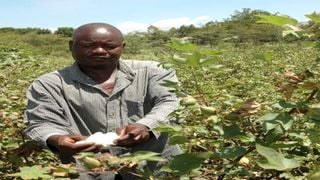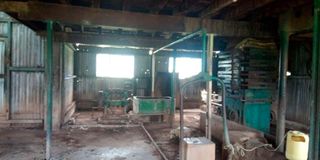
Mr Tom Okayo of Pedo village in Homa Bay County harvests cotton.
| File | Nation Media GroupHoma Bay
Premium
With cotton revival pledge a mirage, Homa Bay farmers despair
A grey gate welcomes you to a once vibrant cotton ginnery on the shores of Lake Victoria in Homa Bay town.
Standing outside the compound, you will easily be convinced that the factory is still functioning and lining cotton farmers’ pockets every month. Large cargo trucks can be seen going in to deliver goods.
One may be forgiven for assuming that the trucks are transporting cotton from local farms to the ginnery, where seeds are separated from the fibre.
But on a closer look, one notices that the vehicles are not designed to carry crops.
The lorries are used by business operators to ferry household items that are stored in warehouses in the compound before they are sold in local shops and supermarkets nearby.
When cotton farming in Homa Bay collapsed in the 1990s due to mismanagement of cooperatives and lack of strong government support, all ginneries in the county locked their gates with no hope of ever reopening.
The dreams of farmers who depended on cotton production were shattered.
The collapse of the industry was attributed mainly to corruption and late payments to farmers. There were massive job losses, condemning many residents to poverty.
The white building in Homa Bay town where ginning machines are locked is in bad shape and can only discourage farmers from growing the crop again.
Its windows are shattered and the roof is worn out. Its cracked walls are now entry and exit points for birds that have turned the building into a nesting ground, affirming the conclusion that plans to revive ginnery operations remain a mirage.
But not all farmers have lost hope.

Some of the machines that were used in cotton processing at the Kendu Bay cotton ginnery.
Some have found solace at a store run by the Homa Bay County Cotton Value Chain Cooperative Union at Makongeni, on the Homa Bay-Kendu Bay road, where cotton farmers can deliver their produce before it is transported to the market.
Union secretary Richard Oloo said it is cheaper for a group of farmers to transport cotton to ginneries than for a single farmer doing so alone.
Most cotton produced in Homa Bay County is transported to Salawa in Baringo County, which is another burden on farmers, who have to spend money on transport besides risking losing their produce to middlemen.
Mr Oloo said some farmers are still passionate about cotton farming, but lack of support from the government has forced them to switch to other crops or entirely abandon farming.
Members of his organisation, he said, are yet to start enjoying the initiative called “Buy Kenya Build Kenya” that is being pushed by President Uhuru Kenyatta after the revival of textile maker Rivatex.
“The government encouraged workers to wear clothes made locally on Fridays. This should boost cotton production in the country. Unfortunately, the President's directive is not helping us,” he said.
One of the challenges affecting cotton production, he said, is that the prices keep plummeting while the cost of buying farm inputs like pesticides increases.
Today, a kilo of cotton is sold for Sh48, down from Sh52 last year, and farmers do not understand the drop.
During bumper harvests between December and May, farmers collectively deliver up to seven tonnes of cotton a day. Trucks then pick up the cotton from Homa Bay and deliver it to Baringo for processing.
Mr Oloo, Farmers pay Sh45,000 to transport eight tonnes (a full lorry) of cotton to the ginnery, Mr Oloo said, with each farmer paying Sh5 per kilo as transport.
“About five farmers can produce seven tonnes of cotton. Imagine paying Sh45,000 on transport to the ginnery when we can spend less if we had ginneries within Homa Bay County,” Mr Oloo said.
Transporters take advantage of the fact that most farmers are elderly citizens who cannot travel far, swindling them of their money.
Shem Opoko, a cotton farmer in Magare village in Homa Bay sub-county, said some middlemen pay less on claims that the farm produce delivered was not of good quality.
“Cotton is graded when being sold to the ginnery and farmers have no control over it at the ginnery. This is where the shortchanging starts,” he said.
The exploitation, Mr Oloo said, happens when dealers in the business collude with the management of the private ginneries to pay less.
“Some farmers have been paid just a fraction of what they delivered. Sometimes farmers give up when the payment is delayed. This is what led to the collapse of the ginneries in Homa Bay, because farmers could not bear the suffering anymore,” he said.
Last year, cotton farmers in Homa Bay started getting support from the government in efforts to revive cotton production.
But it was only for a short while, as this year none of the 3,000 farmers got any support, according to Mr Oloo.
Some farmers who vividly recall the lost glory of the sector believe resuscitating cotton production in Homa Bay is a move in the right direction.
Rivatex began by supplying free pesticides to farmers.
Homa Bay Woman Representative Gladys Wanga led senior officials from the company to Pala in Rachuonyo North where farmers shared their problems.
The Industrialisation principal secretary at the time, Francis Owino, also attended the meeting, where farmers were assured that Rivatex would buy cotton from Homa Bay as it currently depends on cotton from Tanzania and a small supply from Kenya.
Mr Owino announced that the State had secured land in Kendu Bay town where a ginnery will be built.
The government secured a title deed for the land and the ginnery was to start cotton processing by October last year.
But one year later, farmers are still waiting for the ginnery, with Mr Oloo describing promises from some of the leaders as mere political statements.
However, Ms Wanga, who chairs the finance committee in the National Assembly, assured farmers that plans to establish a ginnery in Homa Bay are in top gear, especially after the Ministry of Finance allocated money to revive cotton farming in Western Kenya and Nyanza.
“I’m very passionate about this matter. We must put money in the pockets of our farmers. Farmers should not transport their produce to private ginneries as it reduces the amount of money each farmer should get,” Ms Wanga told an assembly sitting recently.
If the initiative becomes a success, it will attract young farmers who shy from cotton production because of challenges like late payments.
Homa Bay County Agriculture Executive Aguko Juma cited apathy among young people and lack of market as the main challenges affecting cotton production in the Nyanza region.
The collapse of ginneries, he said, played a key role in discouraging many farmers from producing cotton, which is slowly being revived.
“Homa Bay sold 500 metric tonnes of cotton last year. We expect to sell up to 1,500 metric ones this year,” he said.





